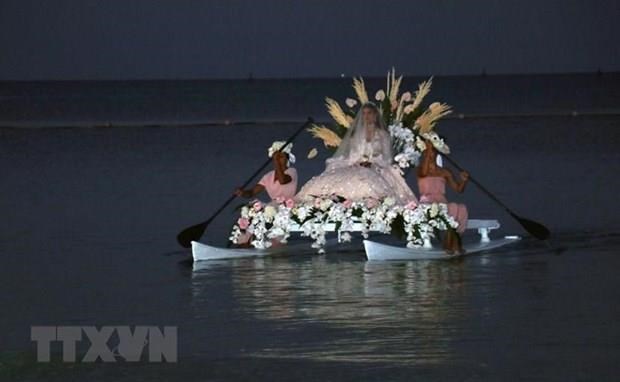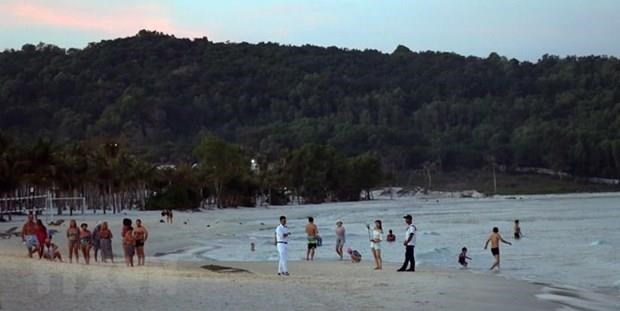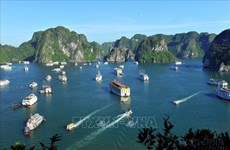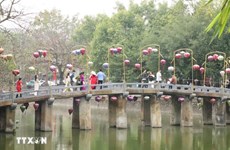Kien Giang develops tourism to tap into natural beauty
The Mekong Delta province of Kien Giang, home to one of the hottest holiday spots in Vietnam – Phu Quoc Island, has experienced a boom in tourism over the last few years.

Hanoi (VNA) – The Mekong Delta province of Kien Giang, home to one of the hottest holiday spots in Vietnam – Phu Quoc Island, has experienced a boom in tourism over the last few years, with the industry now the largest contributor to the local economy.
Kien Giang welcomed more than 19 million domestic tourist arrivals and more than 1 million foreigners from 2016 – 2018 with annual growth of 21.8 percent. Revenue from tourism reached about 11 trillion VND (473 million USD) in the period, up 23.9 percent annually.
In the first half of 2019, the province served more than 4.2 million holidaymakers, up 9 percent year on year, who mostly visited the island districts of Phu Quoc and Kien Hai, and the seaside city of Ha Tien.
Revenue from tourism exceeded 4.26 trillion VND, a year-on-year surge of 42.6 percent, according to the provincial Department of Tourism.
Located 46km from the mainland, Phu Quoc Island is among Vietnam’s top holiday spots and the biggest island in the country. Last year, the island received more than 2.2 million visitors, a 36-percent year-on-year increase. This included over 392,000 foreigners, up 35.5 percent.
The island is expected to become an international hub for eco-tourism, resort tourism and entertainment.
With white sandy beaches and balmy weather almost year-round, Phu Quoc is a holiday-goers’ paradise. It is also famous for pearl farming, fish sauce, pepper, and “ruou sim” – a wine made from sim fruit or rose myrtle.
Since the island was connected to the national electricity grid and a visa waiver policy which gives foreigners a 30-day visa-free stay was launched in 2014, foreigners have been flocking to the island.
Apart from its natural beauty, the island also attracts visitors with luxury resorts, golf courses, animal safari and casinos.
The Vinpearl Phu Quoc complex, developed by Vingroup in the north of the island and consisting of a five-star hotel and villas, a modern amusement area, a golf course and the world’s second biggest wildlife safari, has become popular with tourists.
Last year, Sun Group inaugurated the world’s longest cable car line over the sea connecting An Thoi Town and Hon Thom Islet, cutting the time for travel, until then by speed boat, by half. The cable car system is part of the Sun World Hon Thom Nature Park in the south of the island.
Thanks to such large projects, the island now has a large number of hotel rooms to meet the rising needs of visitors.
In March, the island dubbed as “pearl island” was the venue for a four-day extravaganza wedding of the rich Indian couple Rushang Shah and Kaabia Grewal. More Indian couples have reportedly made plans to tie the knot on the island for this year and later.
 Indian bride Kaabia Grewal during her luxurious wedding on Phu Quoc Island in March. (Photo: VNA)
Indian bride Kaabia Grewal during her luxurious wedding on Phu Quoc Island in March. (Photo: VNA)
Besides Phu Quoc, the Nam Du Archipelago and Lai Son Island in Kien Hai district and Hai Tac Archipelago in Ha Tien city have been recognised by local authorities as the province’s tourist zones.
Nam Du Archipelago consists of 21 islands and islets. The archipelago is often referred to as a miniature Ha Long Bay in the south, but unlike its tourist-clogged northern counterpart, it is rather untouched.
With picturesque scenes, Lai Son Island has quiet fishing villages, luxuriant fruit orchards and beautiful beaches surrounded by coconut trees. Bai Bang is the most beautiful beach with soft sand and clear water. A waterfall runs from Ma Thien Linh Mountain, the island’s highest peak, to Bai Bang Beach.
Ha Tien sits on the Dong Ho Lake and is surrounded by towering limestone formations that support a network of caves, some of which have been turned into temples.
The city has many attractions including historical monuments, such as Mac Cuu Mausoleum, Tam Bao Pagoda and the memorial complex of Chieu Anh Cac – a literary and poetry society established in the city in 1736.
The sea off Ha Tien, with its turquoise waters, clean beaches and odd-shaped rocks is another attraction. Watching the sunset at Mui Nai Beach, which is lined with hundreds of ancient Malabar almond trees, is a must-have experience.
About 90km southeast of Ha Tien, Rach Gia city was the country’s first locality to build a new urban area on land reclaimed from the sea, covering 420,000 hectares.
The city is renowned for several cultural and historical sites that have unique architectural styles boasting a combination of Vietnamese, Chinese and Khmer cultures.
 U Minh Thuong National Park in Kien Giang. (Photo: VNA)
U Minh Thuong National Park in Kien Giang. (Photo: VNA)
U Minh Thuong National Park in the communes of Minh Thuan and An Minh Bac was recognised as the eighth Ramsar site in Vietnam in 2016. It has 21,107 hectares of freshwater wetlands, peat forest, seasonally inundated grasslands and swamp.
The national park is home to distinctive flora and fauna with 32 mammal species, 187 bird species, 34 reptile and amphibian species and 37 varieties of fish, besides 203 insect species. Many of these are threatened creatures, such as the endangered yellow-breasted bunting, yellow-headed temple turtle and Sunda pangolin.
Blessed with such untouched beauty and cultural richness, Kien Giang aims to make tourism a key industry for the locality and make itself a tourism hub.
The province is promoting itself as a safe and friendly destination among domestic and international tourists, said Director of the provincial Department of Tourism Tran Chi Dung.
 Visitors on Khem Beach on Phu Quoc Island. (Photo: VNA)
Visitors on Khem Beach on Phu Quoc Island. (Photo: VNA)
It has been focusing on developing local infrastructure, restoring and preserving historical and cultural relics, and soliciting investment in tourism.
The province has created a number of incentives for investors and encouraged small- and medium-sized enterprises and household businesses to expand and upgrade tourism establishments to better serve visitors.
It has exerted efforts to develop community-based tours, handicraft villages and support services while improving quality of human resources in the service sector.
In addition, the province has tightened the management and protection of the local environment and natural resources and better managed waste and wastewater treatment. It has also created tourism links with other cities and provinces to diversify and enhance the quality of local tourism products. –VNA
Kien Giang welcomed more than 19 million domestic tourist arrivals and more than 1 million foreigners from 2016 – 2018 with annual growth of 21.8 percent. Revenue from tourism reached about 11 trillion VND (473 million USD) in the period, up 23.9 percent annually.
In the first half of 2019, the province served more than 4.2 million holidaymakers, up 9 percent year on year, who mostly visited the island districts of Phu Quoc and Kien Hai, and the seaside city of Ha Tien.
Revenue from tourism exceeded 4.26 trillion VND, a year-on-year surge of 42.6 percent, according to the provincial Department of Tourism.
Located 46km from the mainland, Phu Quoc Island is among Vietnam’s top holiday spots and the biggest island in the country. Last year, the island received more than 2.2 million visitors, a 36-percent year-on-year increase. This included over 392,000 foreigners, up 35.5 percent.
The island is expected to become an international hub for eco-tourism, resort tourism and entertainment.
With white sandy beaches and balmy weather almost year-round, Phu Quoc is a holiday-goers’ paradise. It is also famous for pearl farming, fish sauce, pepper, and “ruou sim” – a wine made from sim fruit or rose myrtle.
Since the island was connected to the national electricity grid and a visa waiver policy which gives foreigners a 30-day visa-free stay was launched in 2014, foreigners have been flocking to the island.
Apart from its natural beauty, the island also attracts visitors with luxury resorts, golf courses, animal safari and casinos.
The Vinpearl Phu Quoc complex, developed by Vingroup in the north of the island and consisting of a five-star hotel and villas, a modern amusement area, a golf course and the world’s second biggest wildlife safari, has become popular with tourists.
Last year, Sun Group inaugurated the world’s longest cable car line over the sea connecting An Thoi Town and Hon Thom Islet, cutting the time for travel, until then by speed boat, by half. The cable car system is part of the Sun World Hon Thom Nature Park in the south of the island.
Thanks to such large projects, the island now has a large number of hotel rooms to meet the rising needs of visitors.
In March, the island dubbed as “pearl island” was the venue for a four-day extravaganza wedding of the rich Indian couple Rushang Shah and Kaabia Grewal. More Indian couples have reportedly made plans to tie the knot on the island for this year and later.
 Indian bride Kaabia Grewal during her luxurious wedding on Phu Quoc Island in March. (Photo: VNA)
Indian bride Kaabia Grewal during her luxurious wedding on Phu Quoc Island in March. (Photo: VNA)Besides Phu Quoc, the Nam Du Archipelago and Lai Son Island in Kien Hai district and Hai Tac Archipelago in Ha Tien city have been recognised by local authorities as the province’s tourist zones.
Nam Du Archipelago consists of 21 islands and islets. The archipelago is often referred to as a miniature Ha Long Bay in the south, but unlike its tourist-clogged northern counterpart, it is rather untouched.
With picturesque scenes, Lai Son Island has quiet fishing villages, luxuriant fruit orchards and beautiful beaches surrounded by coconut trees. Bai Bang is the most beautiful beach with soft sand and clear water. A waterfall runs from Ma Thien Linh Mountain, the island’s highest peak, to Bai Bang Beach.
Ha Tien sits on the Dong Ho Lake and is surrounded by towering limestone formations that support a network of caves, some of which have been turned into temples.
The city has many attractions including historical monuments, such as Mac Cuu Mausoleum, Tam Bao Pagoda and the memorial complex of Chieu Anh Cac – a literary and poetry society established in the city in 1736.
The sea off Ha Tien, with its turquoise waters, clean beaches and odd-shaped rocks is another attraction. Watching the sunset at Mui Nai Beach, which is lined with hundreds of ancient Malabar almond trees, is a must-have experience.
About 90km southeast of Ha Tien, Rach Gia city was the country’s first locality to build a new urban area on land reclaimed from the sea, covering 420,000 hectares.
The city is renowned for several cultural and historical sites that have unique architectural styles boasting a combination of Vietnamese, Chinese and Khmer cultures.
 U Minh Thuong National Park in Kien Giang. (Photo: VNA)
U Minh Thuong National Park in Kien Giang. (Photo: VNA)U Minh Thuong National Park in the communes of Minh Thuan and An Minh Bac was recognised as the eighth Ramsar site in Vietnam in 2016. It has 21,107 hectares of freshwater wetlands, peat forest, seasonally inundated grasslands and swamp.
The national park is home to distinctive flora and fauna with 32 mammal species, 187 bird species, 34 reptile and amphibian species and 37 varieties of fish, besides 203 insect species. Many of these are threatened creatures, such as the endangered yellow-breasted bunting, yellow-headed temple turtle and Sunda pangolin.
Blessed with such untouched beauty and cultural richness, Kien Giang aims to make tourism a key industry for the locality and make itself a tourism hub.
The province is promoting itself as a safe and friendly destination among domestic and international tourists, said Director of the provincial Department of Tourism Tran Chi Dung.
 Visitors on Khem Beach on Phu Quoc Island. (Photo: VNA)
Visitors on Khem Beach on Phu Quoc Island. (Photo: VNA)It has been focusing on developing local infrastructure, restoring and preserving historical and cultural relics, and soliciting investment in tourism.
The province has created a number of incentives for investors and encouraged small- and medium-sized enterprises and household businesses to expand and upgrade tourism establishments to better serve visitors.
It has exerted efforts to develop community-based tours, handicraft villages and support services while improving quality of human resources in the service sector.
In addition, the province has tightened the management and protection of the local environment and natural resources and better managed waste and wastewater treatment. It has also created tourism links with other cities and provinces to diversify and enhance the quality of local tourism products. –VNA












